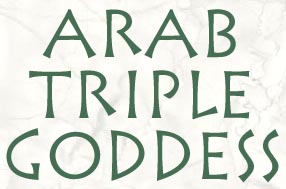 
The Goddesses Al-Uzza, Al-Lat and Menat formed a triad in pre-Islamic Arabia. They were widely worshipped: from Nabatean Petra in the North to the legendary Kingdoms of Arabia Felix in the South, including Saba, the Biblical Sheba; as far east as Iran and Palmyra; and the three of them were very popular Goddesses in Mecca at the time of Mohammed. From left they are: Al-Uzza, whose name means "The Mighty One", the Goddess of the Morning Star; Al-Lat, the Mother, whose name means simply "The Goddess", as Al-Lah simply means "The God"; and Manat, Crone-goddess of Fate or Time. Sometimes the three of them are referred to as the daughters of Al-Lah; sometimes Manat and Al-Lat are considered daughters of Al-Uzza. Al-Uzza, "the Strong One", was one of the most venerated Arab Deities, and the Goddess of the morning and evening star, Venus. She had a temple at Petra (though which one that was has not been determined), and may well have been the patron Goddess of that city. Isaac of Antioch (a writer of the 5th century CE) calls Her Beltis ("Lady", a title shared by many other Semitic Goddesses), and Kaukabta, "the Star". He also says that women would invoke Al-Uzza from the rooftops, a form of worship appropriate to a Star Goddess. St. Epiphanius of the 4th century CE calls Her the mother of Dusares, the local mountain God, calling Her by the title Chaamu or Chalmous, meaning "young girl or virgin". She has connections with the acacia tree, and Her sanctuary at Nakhlah had three acacias in which She was believed to descend. She has much in common with Ishtar and Astarte as Morning and Evening Star Goddesses—they all have aspects of both Love and War Goddess, and big cats were sacred to Them. She is shown here armed as a bellatrix, standing before an acacia tree, with a caracal, or desert lynx. She was associated by the Greeks with their Aphrodite Urania, "Heavenly Aphrodite". Al-Lat, whose name is a contraction of al-Illahat, "the Goddess", is mentioned by Herodotus as Alilat, whom he identifies with Aphrodite. She is sometimes also equated with Athena, and is called "the Mother of the Gods", or "Greatest of All". She is a Goddess of Springtime and Fertility, the Earth-Goddess who brings prosperity. She and Al-Uzza were sometimes confused, and it seems that as one gained in popularity in one area the other's popularity diminished. The sun in Arabia was called Shams and considered feminine, and may represent an aspect of Al-Lat. She had a sanctuary in the town of Ta'if, east of Mecca, and was known from Arabia to Iran. Her symbol is the crescent moon (sometimes shown with the sun disk resting in its crescent), and the gold necklace She wears is from a pendant identified to Her. As a Fertility-Goddess She bears a sheaf of wheat; and in Her hand She holds a small lump of frankincense, as Her emblem is found carved on many incense-holders. Manat or Manawayat derives Her name from Arabic maniya, "fate, destruction, doom, death", or menata, "part, portion, that which is alloted". She is a very ancient Deity and Her cult may precede both Al-Uzza's and Al-Lat's. Her cult was widespread, though She was particularly worshipped as a black stone at Quidaid, near Mecca. She is connected with the great pilgrimage, as Her sanctuary was the starting point for several tribes. She is known from Nabatean inscriptions, and tombs were placed under Her protection, asking Her to curse violators. She is accordingly a Goddess of Death, and Maniya (Death personified) is mentioned in poetry as actively bringing a person to his or her grave, holding out the cup of death. She is shown as an old woman with a cup, and the symbols at the bottom of Her gown spell Her name in Sabaic (which does not use vowels and is written right to left), M-n-t. The waning moon is shown over Her head as the symbol of the Crone-Goddess of Death. I've also done another piece of art of Al-Uzza, as part of the World Goddess Oracle. This design is available on prints through ArtPal. |